The current state of the automotive industry can best be described as transformational, disruptive, and significant. The rise of hybrid, connected, and self-driving vehicles is rapidly reshaping the industry. We can expect automotive industry change on par with other historical auto innovations. In fact, it is estimated that 10 million self-driving cars will be on the streets by 2020, with autonomous vehicles becoming commonplace as soon as 2020.
-3.jpg?width=1200&name=1200x627-2%20(1)-3.jpg)
Historical Snapshot of Major Automotive Events:
1908: Ford reveals the Model T, sold to “average” families
1934: The first successful mass produced car is introduced
1939: First air conditioner revealed
1950: Cruise control brings convenience to driving
1966: Electronic fuel injection system is manufactured
1970: Airbags become standard is most vehicles
1985: First Anti lock braking system is created
Every decade or so, the automotive industry has experienced a focused wave of innovation. Among these innovations are mass production, safety awareness, improved fuel economy, and most recently hybrid and environmentally friendly vehicles. These automotive industry changes are driven by economical fluctuations as well as consumer demand. The next wave is no different.
5 Major Changes Coming to The Automotive Industry
1. Insurance
Autonomous vehicles will have a big impact on the insurance industry as we know it. It is important to note that the industry will more than likely not be eliminated due to “perfect” safety records. At $220 billion in annual revenue and nearly 300,000 jobs generated, the industry is massive enough to pivot, although declines are predicted.
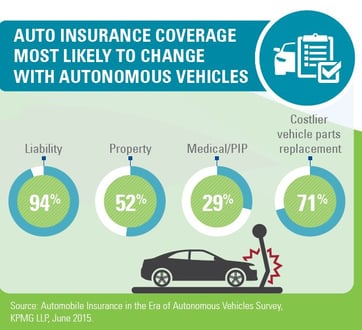
The most anticipated changes include micro-risks and micro-premiums that sync to real time data generated by autonomous vehicle processors. The party responsible for paying insurance premiums will also shift, as individual states develop specific laws. For example, a recently passed law in Michigan states automakers are liable for insurance for every car when driver-less systems are at fault.
These changes will be gradual as regulatory bodies, governments, manufacturers, and consumers all adapt driver-less technology in their day to day lives.
2. Infrastructure
The current state of the United States road and bridge infrastructure is bleak. An estimated 65% of US roads are in poor condition, according to the US Department of Transportation. Even Tesla founder Elon Musk was reported to be at the mercy of poor infrastrcuture after his Tesla Autopilot feature failed to recognize which lane it was in due to the lack of lane markings.
Autonomous vehicles will require light detection technologies, radar, cameras, sensors, and traffic signals that can integrate with these technologies. This technology has been coined vehicle-to-infrastructure communication, which is the process of a car network communicating with the infrastructure around it. This communication can determine speed, safety procedures, and optimize the car’s fuel and energy consumption.
It will be interesting to see what comes first – infrastructure improvements or technology. Industry bets are currently on the technology outpacing infrastructure advancements, as tech and auto companies can outright fund their technology advancement without government support. The same can’t be said about public infrastructure.
3. Regulations
In 2017, 33 states introduced legislation related to autonomous vehicles and 13 states actually enacted specific legislation focused on autonomous vehicles:
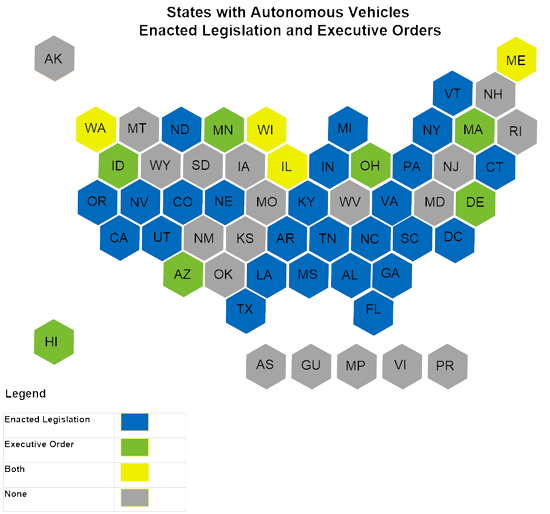
Most of the legislation passed so far focuses on defining what exactly constitutes an autonomous vehicle and what testing should be done. As previously mentioned, vehicle to infrastructure communication, along with vehicle to vehicle communication, will also be major focus points for future regulation. Privacy concerns with real time data will be at the forefront, as well as the general safety and accuracy of such communications.
McKinsey in Co. estimates that once technological and regulatory issues have been resolved, up to 15% of new cars sold in 2030 could be fully autonomous.
4. Manufacturing and Industry Shifts
Driven by shared mobility, connectivity services, feature upgrades, and new business models, the automotive industry’s total revenue has the potential to grow by 30%, adding up to $1.5 trillion to the economy.
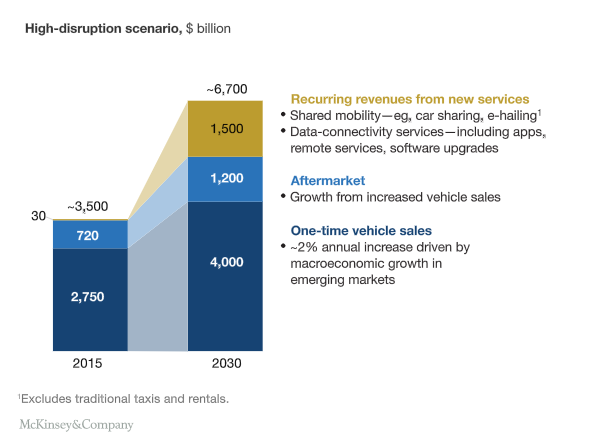
Additionally, R&D budgets and spending are expected to grow in the industry, as automakers focus on developing new features and staying ahead of the data and connectivity curve. Each core technology will have a trickle down effect to apps, service providers, software upgrades, and more features to enhance the overall autonomous vehicle experience.
5. Consumer Ownership Shifts and Demand
Despite some general concern about the negative consequences that widespread autonomous technology could cause, general consumer interest in self-driving vehicles is increasing. By 2030, autonomous vehicles will represent roughly 25% of the total passenger vehicle population. Another large percentage of cars on the road will be "connected", with data reinforcing critical system components. Of course, not everyone will be a fan of these emerging technologies.
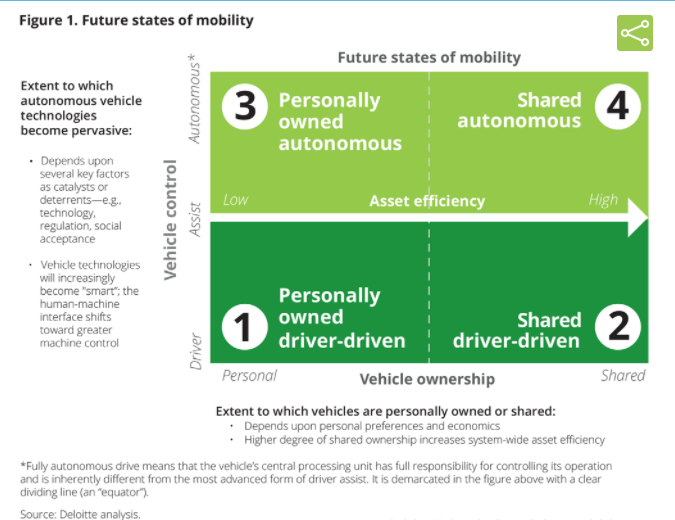
Trust is a key component to widespread adoption, with many consumers concerned about the symmetry between autonomous vehicles and traditional vehicles. According to Deloitte, the two greatest uncertainties are the amount of vehicles that are owned vs. shared and the extent to which vehicles are controlled by humans vs. technology. Right now this balance is unknown and the general population is divided between wants, needs, and resources.
In general, given a gradual and transparent shift, most consumers would be open to exploring the option to try or use autonomous vehicles. This can be seen with the increase in consumer demand for connected technology and the latest features in new car purchases.
Conclusion
Innovation will likely bring massive automotive industry change to the industry in as little as the next five years. Automakers, consumers, and governments will need to adapt and be trained for such change. The disruption will be felt by all segments of society, with automakers and tech companies being at the forefront of educating and easing awareness and adoption rates. These top-down initiatives will help determine just how quickly autonomous vehicle technology is adopted on a widespread level. One thing is for sure, the industry will never be the same.
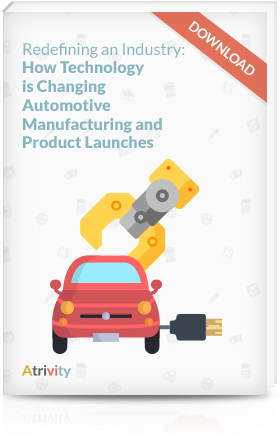 How is technology redefining automotive manufacturing and product launches? From the consumer, to the competitors, to the new way to market and the future ahead of us.
How is technology redefining automotive manufacturing and product launches? From the consumer, to the competitors, to the new way to market and the future ahead of us.-
Is automotive technology important for end consumers?
-
Balancing consumer demand & competitive advantages
-
Autonomous vehicles
-
Future of automotive product launches
-
Preparing for the future
-
Exclusive TLDR summary





-1.jpg)
.jpg)

